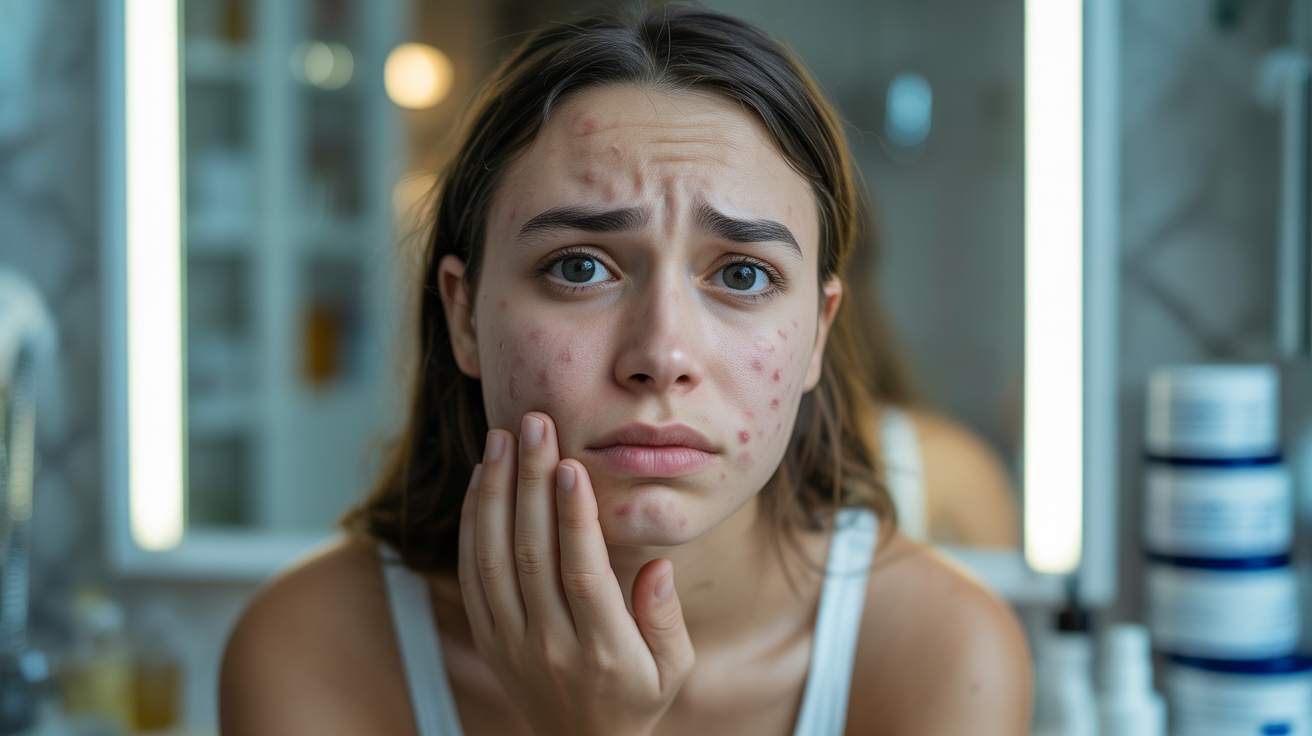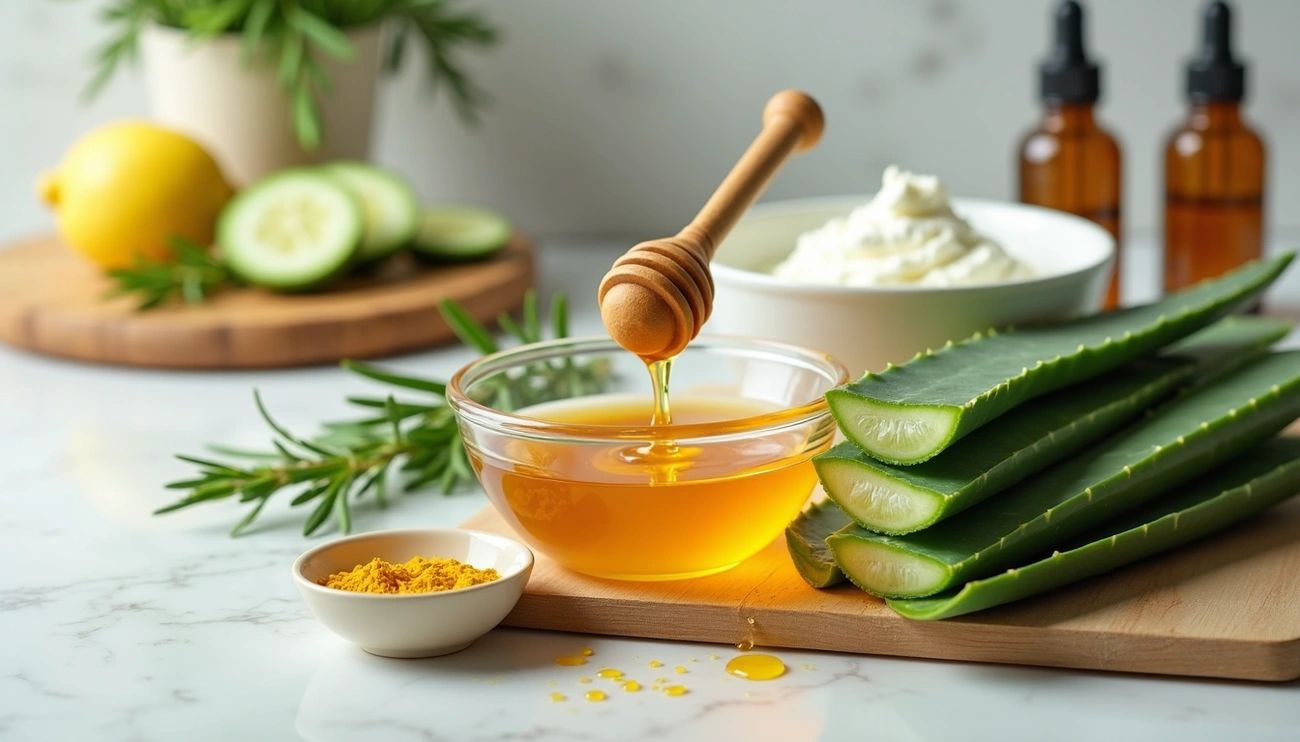Acne affects around 200-300 million Indians yearly, and many people turn to home remedies when pimples appear. These natural solutions have become popular among those dealing with this common skin issue.
Research shows that 80% of people aged 11-30 get acne breakouts. Traditional treatments with salicylic acid and benzoyl peroxide work well, but can be costly and harsh on your skin. Natural home remedies provide a gentler alternative that many people find helpful.
Pimples affect both your skin and self-confidence. Your kitchen likely contains several ingredients that can help fight acne naturally. Tea tree oil, aloe vera, turmeric, and neem have shown great results in treating various acne problems like blemishes, dark spots, and scars.
Simple lifestyle changes can significantly reduce acne breakouts. Drinking enough water, keeping stress levels low, choosing oil-free skincare products, and resisting the urge to touch pimples all help maintain clear, healthy skin. This piece explores these natural approaches that can transform your skincare routine.
Understanding Pimples and Their Causes
Pimples take time to develop through several complex steps under your skin. Let’s understand what happens beneath the surface before jumping into home remedies. This knowledge will help you treat them better.
What causes pimples to form
Your skin has tiny openings that contain hair follicles and oil glands (sebaceous glands). These glands produce sebum that keeps your skin moisturized and protected. The trouble starts when too much oil mixes with dead skin cells and blocks the pore. This creates a tiny blockage called a microcomedone – a baby pimple you can’t see yet. The clogged pore then leads to more buildup.
Here’s what triggers this process:
- Hormonal changes: Your body produces androgens (hormones that spike during puberty) that make oil glands bigger and produce more oil. Changes during periods, pregnancy, or conditions like polycystic ovary syndrome can also trigger breakouts.
- Bacteria: Clogged pores create a perfect environment for Propionibacterium acnes bacteria to grow faster. These bacteria feed on your skin’s oil and produce substances that cause redness and swelling.
- Genetics: Your parents’ acne history can affect you. Research shows that if both your parents had acne, you might get it earlier and worse.
- Diet: While debatable, foods that spike blood sugar might increase insulin and boost oil production. But vitamins A, D, and E can help maintain healthy skin.
Types of pimples you may encounter
Pimples show up in different ways based on how severe they are:
- Whiteheads (closed comedones): Small white bumps form under your skin when plugged follicles stay covered. The skin around them usually stays normal without redness.
- Blackheads (open comedones): These appear when clogged pores open at the surface. They look dark because air changes the oil’s color, not from dirt.
- Papules: These red, tender bumps feel hard and make your skin rough. They form when inflammation damages the follicle walls.
- Pustules: These are your typical pimples – red bumps with pus at the top.
- Nodules: Deep, painful bumps that need prescription medicine because regular creams can’t reach them [16, 26].
- Cysts: These painful, pus-filled lumps develop deep under your skin. They’re the worst type of acne and often leave scars.
Why are natural remedies gaining popularity?
Regular acne treatments like salicylic acid and benzoyl peroxide work well, but people are switching to natural options. Here’s why:
Prescription medications often bring unwanted effects. Take isotretinoin – it can cause liver problems and affect blood fats. Skin creams might burn or irritate, and antibiotics could make bacteria resistant.
Natural ingredients can tackle multiple problems at once with fewer side effects. Tea tree oil fights bacteria like benzoyl peroxide but treats your skin more gently. Zinc helps wounds heal and reduces inflammation, which might improve your acne.
Natural products are budget-friendly and easy to find. You probably have many effective acne-fighting ingredients in your kitchen right now.
8 Kitchen Remedies That Work
“”This may be helpful as a home remedy for foot fungus in a diluted form. I wouldn’t recommend a non-diluted form on the face, it could cause irritation.”” — Dr. Julia Tzu, Founder and Medical Director of Wall Street Dermatology
Want to get rid of acne using kitchen cabinet remedies? These eight natural treatments are a great way to get clearer skin without harsh chemicals. You probably have most of these ingredients at home already.
1. Tea tree oil for spot treatment
Tea tree oil comes from the Australian Melaleuca alternifolia tree leaves. It has strong antibacterial and anti-inflammatory properties that help curb acne-causing bacteria. Research shows tea tree oil can substantially improve mild to moderate acne with few side effects. Here’s how to use it safely:
Mix 1 part tea tree oil with nine parts water since it’s too strong to use directly on your skin. Use a cotton swab to apply the mixture to problem areas 1-2 times daily. Make sure to do a patch test first because some people might get skin irritation.
2. Aloe vera for soothing inflammation
The thick leaves of aloe vera plants give us a gel that’s amazing for acne treatment. Its antibacterial and anti-inflammatory properties help calm irritated skin and reduce pimple redness.
Start by applying pure aloe vera gel straight to clean skin as a natural cleanser or spot treatment. You can leave it on troubled spots overnight to improve results. Another option is to make a cooling mask by mixing aloe vera with a quarter teaspoon of lemon juice (use eight parts aloe to 1 part lemon).
3. Apple cider vinegar as a natural toner
The natural acids in apple cider vinegar balance skin pH and kill bacteria. Make a simple toner by mixing two tablespoons of apple cider vinegar with about 8 ounces of water. People with oily skin can add a teaspoon of witch hazel to get extra astringent benefits.
Use a cotton pad to apply this after cleansing and before moisturizing. Keep the mixture at room temperature and use it regularly to see the best results.
4. Honey and cinnamon mask for bacteria control
Honey and cinnamon both kill microbes that cause acne. The high sugar content in honey puts pressure on bacterial cells to stop them from multiplying. Cinnamon naturally shrinks pores with its astringent properties.
Create this mask by mixing three tablespoons of raw honey (Manuka works best) with 1 tablespoon of true cinnamon. Spread it evenly on your face and wait 10-15 minutes before rinsing with warm water. Do a patch test first because cinnamon might irritate sensitive skin.
5. Turmeric and yogurt for brightening
Turmeric contains curcumin that offers substantial anti-inflammatory and antibacterial benefits for acne-prone skin. Mix it with yogurt’s lactic acid and you get a powerful mask that treats breakouts and fades scars.
Combine one teaspoon of turmeric with two tablespoons of plain yogurt. Leave this mask on your face for 15-20 minutes, then rinse with lukewarm water. This mix helps reduce inflammation, fights bacteria, and brightens your skin tone.
6. Neem and rose water cleanser
Neem extract kills bacteria and works well against acne. Rose water helps balance skin pH and tighten pores, making them perfect partners in a natural cleanser.
Mix neem extract with rose water and massage it into your face using circular motions. This blend removes dirt, excess oil, and bacteria while it soothes irritated skin.
7. Lemon juice for fading marks
The citric acid in lemon juice is a natural source of vitamin C that can help lighten dark spots and reduce acne scars. Be careful, though – it makes your skin more sensitive to the sun.
Mix equal parts fresh lemon juice and water for spot treatment. Apply carefully with a cotton swab, rinse with lukewarm water after a few seconds. Use this a few times weekly until your blemishes fade.
8. Cucumber and witch hazel toner
Cucumber extract hydrates and soothes, while witch hazel reduces inflammation naturally. Together, they make an effective toner that tightens pores and controls oil.
Put cucumber extract and witch hazel in a spray bottle to make this refreshing toner. Apply it to clean skin with a cotton pad or spray directly on your face, staying away from your eyes. This cool mist reduces inflammation and controls oil production, making it perfect for acne-prone skin.
How to Remove Pimple Marks Naturally at Home
“”Sounds delicious and appealing, but not exactly the treatment for acne. Medical grade honey (manuka) might be helpful as an antibacterial agent, but again, not a fix for acne.”” — Dr. Julia Tzu, Founder and Medical Director of Wall Street Dermatology
Pimples leave behind stubborn marks and scars that can last for months after healing. The good news is that your kitchen has several ingredients that can help fade these reminders of past breakouts. Let’s look at three natural remedies that work to target pimple marks and bring back your skin’s even tone.
Using rosehip oil for scar fading
Rosehip oil is a standout among natural scar treatments because it contains essential fatty acids and vitamin C. This potent mix helps your skin repair itself naturally. Research backs this up – patients who applied rosehip oil twice daily for six weeks showed clear improvement in post-surgical scars and reduced redness.
The oil gets its healing power from these fatty acids:
- Linoleic acid
- Oleic acid
- Linolenic acid
These compounds help your cells become softer, more porous, and better at healing. You’ll see the best results by applying pure rosehip oil directly to acne scars twice daily. Most people notice changes after 6-12 weeks of regular use. Rosehip oil doesn’t just help with scars – it also helps control sebum production, which might prevent new breakouts.
Baking soda for gentle exfoliation
Baking soda acts as a natural exfoliant that removes dead skin cells around acne scars and encourages new cell growth. Its gentle abrasive texture and alkaline properties make it great for skin resurfacing.
Creating an exfoliating treatment is simple. Mix 1-2 teaspoons of baking soda with enough water to make a paste. Apply this mixture to damp skin using gentle circular motions, focusing on scarred areas. Rinse it off right away and use moisturizer to prevent dry skin.
Keep in mind that you should use this treatment no more than twice weekly. Your skin’s natural pH balance can get disrupted with overuse. Baking soda has a pH of 9, while healthy skin stays between 4.5 and 5.5. Using it too much or too often can strip away essential oils and make skin problems worse.
Lemon and honey for lightening dark spots
Lemon and honey work together to fade dark spots effectively. Lemon juice has vitamin C and natural acids that lighten dark spots, while honey’s antibacterial properties help with healing.
Making this remedy is easy. Mix equal amounts of lemon juice and honey. One teaspoon of each is enough for spot treatment. Put it directly on pimple marks and wait 10-15 minutes before washing with lukewarm water.
This treatment needs careful handling. Lemon’s high acidity might irritate sensitive skin or make it more sun-sensitive. Mix lemon juice with equal parts water if you have sensitive skin, and stay out of the sun after using it. Adding a quarter teaspoon of turmeric powder to this mixture might help reduce dark spots even more.
Your pimple marks will gradually fade with regular use of these natural remedies. Natural treatments take time to work, so you’ll likely see results after a few weeks of consistent use.
Lifestyle Habits That Support Clear Skin
Natural remedies can help you manage acne without harsh chemicals or expensive treatments. Simple solutions from your kitchen cabinet can tackle both active breakouts and the marks they leave behind.
These home remedies are effective because they target different aspects of acne at once. Tea tree oil and honey eliminate bacteria. Aloe vera and turmeric help reduce inflammation. On top of that, ingredients like rosehip oil help heal your skin and fade scars over time.
The most significant factor in using natural remedies is consistency. You won’t see results right away, but most people notice improvements within weeks if they stick to regular applications. Keep in mind that skin responds differently for everyone, so you might need to try different combinations to find what works best.
These natural solutions work best when they’re part of a complete skincare routine. Clear skin comes from drinking enough water, eating well, and keeping your hands away from your face. The solution to your acne problems might be sitting in your kitchen cabinet right now.
You don’t need harsh chemicals or costly treatments to get clearer skin. These proven remedies offer a gentle way to manage acne while supporting your skin’s ability to heal naturally. Give these kitchen cabinet solutions a try – your skin will thank you.
Natural remedies from your kitchen can work better than creams and prescriptions for troublesome skin. This piece explores proven home treatments for pimples that use simple ingredients to curb acne naturally and effectively.
These natural approaches don’t require expensive products. Tea tree oil’s antibacterial properties and aloe vera’s soothing effects are great alternatives to chemical treatments.
These methods are a great way to get results because they tackle existing breakouts and prevent new ones. You’re building a complete strategy for clearer skin by adding these solutions to your skincare routine and following the lifestyle habits we discussed.
Natural remedies need patience. Harsh chemicals might show quick results, but they damage your skin’s health. Gentler options improve your skin’s condition gradually over time.
Your skin’s response matters when trying these kitchen cabinet solutions. Everyone’s skin reacts differently – a treatment that works perfectly for someone might not suit you. Watch how your skin responds and adjust your routine.
Clear skin comes from understanding breakout science and knowing which natural ingredients manage them best.



3 thoughts on “Home Remedies for Pimples : Your Kitchen Cabinet Acne Solution Guide”